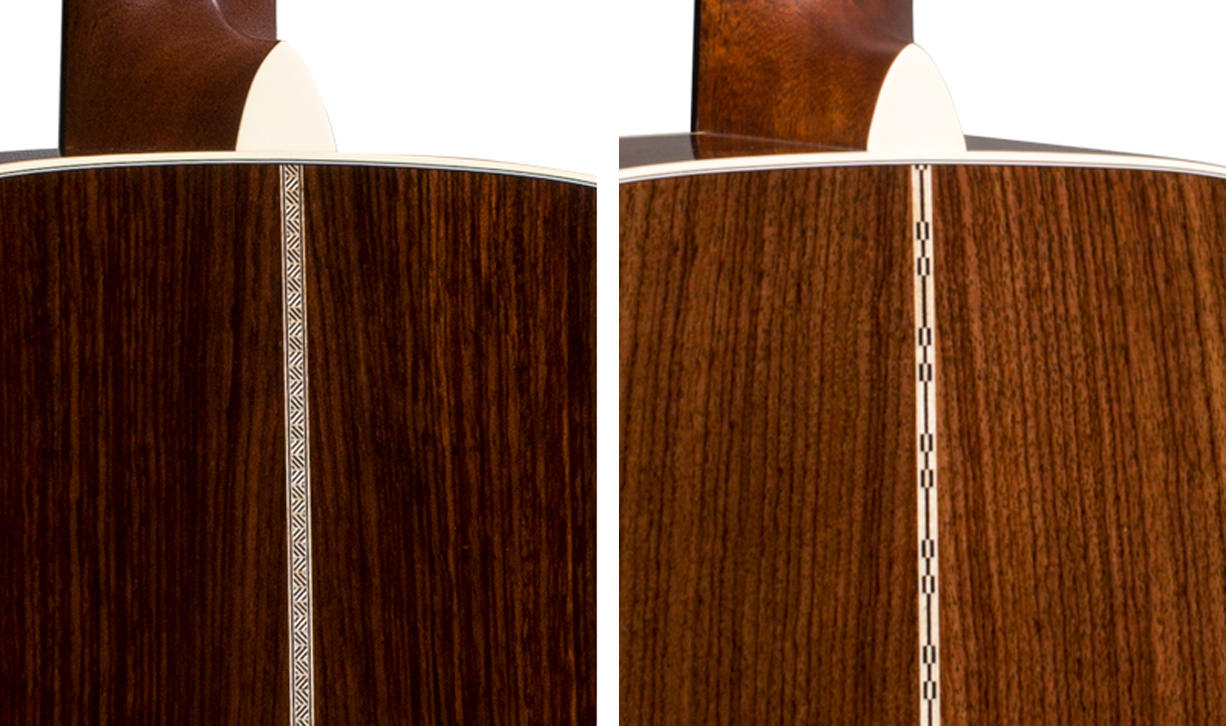Tag: D-41
Martin’s Standard Series Has Been Standardized For 2018
C. F. Martin & Co. unveils a “reimagined Standard Series” for Winter NAMM 2018
The D-45 gets new binding and Style 28 returns to its roots while embracing Martin’s vision of its future.
More New Old Martins
The entire Standard Series that defines Martin guitars to the world has been uniformly converted to vintage guitar aesthetics achieved by applying Aging Toner to the Sitka spruce tops. While the Standard Style 18 and 21 models retain the faux tortoise binding of their predecessors, those made in Style 28, 35, 36, 40, 41, 42, and 45 all sport the Antique White binding introduced on select models in recent years.
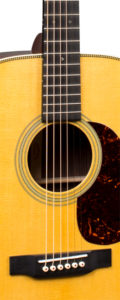 |
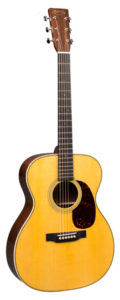 |
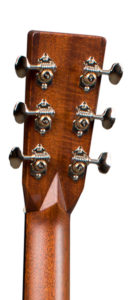 |
Photos: The 000-28 (2018) replaces the last hold-out of the old Standard Series (click to enlarge)
Gone are the stark white bindings and the last of the black pick guards. Gone too are the tops with the natural French vanilla color slowly yellowing across the years as sunlight tans them toward butterscotch and onto pumpkin orange as the decades roll by. The appearance of the Aging Toner has been formulated to fall somewhere between Martin’s previous offerings of vintage-esque hues, and lands more in the butterscotch spectrum than not. Many of the new Standard Series models can be ordered with a Sunburst top or an Ambertone top.
Diamonds in the Black
Similar to the makeover given to Standard Style 18 a few years back, which combined Martin’s modern High Performance Neck with the scalloped forward-shifted bracing, tonewoods, and open-back tuners of the old Vintage Series 18s, the domino dots and black and white line inlay of last year’s 28s have been retired in favor of the bold herringbone trim around the top, and the diamond position markers gleaming from the black ebony fretboards of the (soon to be) extinct Vintage Series 28s. And the entire Standard Series will likewise be getting the High Performance Neck. Their marketing data suggests it is the best way to guarantee Martin’s cash flow remains very much in the black.
The High Performance Neck combines a Modified Low Oval shaping to the neck itself with a fretboard that has the High Performance Taper, measuring 1-3/4” wide at the nut, and 2-1/8” at the 12th fret – specs that have become the industry standard among popular guitarmakers. It does appear that Martin has made its last 1-11/16” Low Profile neck, other than on possible future special or limited editions.
That the HD-28 was being remade with the HP Neck in the image of the HD-28V has been known to me for some time now. But whether they would be uniformly remaking all the 28s was an open question until quite recently.
As the man with his name on the headstock, CEO Chris Martin remains intimately involved with many of the decisions that lead to just which Martin guitars end up for sale and when they will appear before the public. For example, it was his fourth quarter decision to withhold certain models from last year’s Winter NAMM until the Summer show. And even then, the revamped Standard D-28 (2017) didn’t get the go light until the last minute.
I was among those holding my breath as to just what exactly would be the final specs of the new Standard Series Martins when they were displayed at the Winter NAMM trade show on January 25, 2018.
One interesting tidbit, the 00-28 and 000-28 are keeping the Style 28 back strip, while the others are moving to the vintagesque zig-zag back strip used on 28s in the pre-WWII years. I had to wait until today’s executive luncheon ended to confirm this is indeed the way things will be at NAMM.
According one of those well-fed execs, “If an H appears in the model name (i.e. HD-28,) then it will have a zig-zag back strip…if no H, it will get a checkerboard pattern,” which appeared on contemporary Style 28 models since the late 1940s.
Photos: A tale of two 28 back strips (click to enlarge)
The H designation once signified herringbone trim and scalloped bracing. In the new Style 28, some guitars with both of those features do not get the H. And yes this does mean the OM-28 (2018) has surrendered its 1930s zig-zag for the 1950s checkerboard. But it and most of the Standard Series instruments with (2018) in the name get an upgrade in tuners, to Schaller GrandTune™ machines. Style 35 guitars retain the chrome enclosed Grover Rotomatics associated with Style 35 throughout its lifetime.
It Is What It Is
Change often comes slowly at Martin Guitars, while some of their biggest fans have a hard time accepting any change at all.
The loss of grained ivoroid bindings from the OM-42 or the additions of Antique White binding and Aging Toner to the top-of-the-line D-45 may seem like sacrilege to some (who had no intention of ever buying a D-45 anyway,) but it is the change to forward-shifted bracing on the HD-28, D-35, D-41, and D-45 that may prove much more controversial in practical terms, just as it has been for the D-28 2017 model that appeared at Summer NAMM.
The term forward-shifted bracing refers to where Martin placed the X brace in relation to the bridge plate on Dreadnought models made in the 1930s. It is often said to be one inch from the sound hole, but it is all about the flexibility of the spruce soundboard around bridge plate, father down the top from the X, which matters. That is where the majority of the sound-producing energy is transferred from the guitar strings to the musical instrument.
The bracing was moved nearer the bridge plate sometime in 1938, to a position now called “rear-shifted bracing.” And then it was brought forward a little bit at a time until the late ’50s, when it reached the position that was considered the “standard position.” That is, until now.
Moving the center of the main X brace that little bit farther away from the bridge plate on a Dreadnought-size guitar increases bass response noticeably, while adding more echoy resonance to the voice in general.
Martin going all-in on forward-shifted bracing (not including 12-string models) will bring further uniformity to the Standard Series, while also severing ties with the Martins made in the final 40 years of the twentieth century, at least when it comes to the brace position. There is no doubt it changes the voice of a guitar. But it will be left to the individual guitarist as to whether that is a good thing or not.
Likewise, the Company is all in on the take-it-or-leave-it stance concerning the High Performance Neck.
While the playability and feel of the HP Neck allows their ship-of-the-line Martins to enter into direct competition with makers like Collings, Huss & Dalton, and Taylor Guitars, not all guitarists are happy with the new Martin neck. They will have to look to Martins outside of the Standard Series when seeking a vintage style V neck, or they must look to the Custom Shop if they want a new Martin with the Low Profile neck from the old Standard Series.
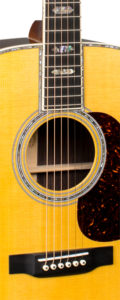 |
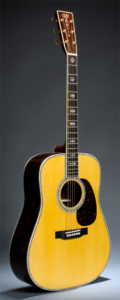 |
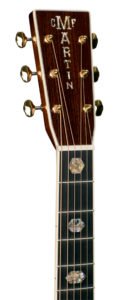 |
Photos: The new D-45 (2018) has vintage looks and modern construction (click to enlarge)
C. F. Martin IV’s Legacy
It can be argued that this reimagined Standard Series may be the most important event in the continued success of the Chris Martin’s family business, since his great-grandfather, Frank Henry Martin, brought the Company into the twentieth-century and piloted it through the Great Depression. It took many years of trial and error to bring all these specs into one unified collection of reasonably-priced, professional-level guitars.
Now in his 60s, today’s Mr. Martin is gearing up to follow his long-time friend Dick Boak into retirement. He will be remembered for leading his Company out of one economic slump and through several others, by embracing and respecting Martin tradition while also introducing and championing modern technologies, and alternate and environmentally responsible materials, often combining the traditional with the futuristic to break new ground that will prove to be sound bedrock for his business to build upon for many years to come.
For guitarists who long for Martin guitars made more like the old timers, he has provided the excellent Authentic Series of meticulous vintage Martin recreations. And for those who want Martin to boldly step outside of their tried and true designs, there are the many special editions and Chris’ own CEO Series.
And now, his transformation of the Standard Series that began with the D-18 makeover in 2012 has come to fruition. By infusing many aesthetic features of old Frank Henry’s pre-war Martins with the modern technology like the High Performance neck, made possible in part by Martin’s exclusive two-way adjustable steel truss rod, the effort to return Martin’s Standard Series to its rightful place as the industry standard for top flight acoustic guitars is fully realized. It may very well be among the wisest moves Chris Martin could make as he prepares for the on-coming century of Martin guitars.
Check back soon, as we will be writing about other new Martins as soon as I am given the permission to start blabbing!
In the mean time…
Check out the new Standard Series Martins and their public spec sheets below
All guitars listed have new specs, or are wholly new to the Martin catalog for 2018.
Martin D-41 VS D-42 – Reader Q&A
A new reader asks about the difference and value of the Martin D-41 vs. D-42
Of splitting hairs and shifting braces
Hi,
I just came across this site a little while ago.
I have the opportunity to buy either a Martin D 41 Standard or a Martin 42 Standard for the exact same price of $4,300.00.
My question is, which would be the better one to buy, in terms of playability, increase in value, sound etc. So far, from what I can tell from reviews, there doesn’t seem to be that great a difference other than about $800 in cosmetics, forward bracing, different tuners, a little more abalone. Is that true or are there other differences?
The price is the same either way at one store the guy offered the D 42 for the price of a D 41. Other stores offer the D 41 for the same price. Both are offered on the net.
Thanks,
K River
Spoon Replies:
Hi K,
If you are talking about new guitars with a full warranty, tax and shipping not included, $4,300 is a good price for a D-42. If not the best price in the country, it is very close. But it is a high price for a new D-41.
Knit One, Pearl 42
When it comes to the specifics of your query, the reason the D-42 costs more (list price $6,999 vs. $5,999) has to do with the pearl inlay more than anything else. No job at Martin takes longer while also requiring the highest paid workers than pearl inlay. The D-42 gets the snowflake pattern on the fingerboard that was originally used on Style 45 in the prewar era. That takes longer to do than the hexagon blocks used on modern Style 45 and Style 42.
The D-42 also gets the pearl inlaid around the fingerboard extension, or “fretinsula” as my friend Tony dubbed it. That is quite difficult to do perfectly and adds time and wages spent.
Style 42 also gets grained ivoroid binding and aging toner on the top, etc. The whole point of the extra pearl and vintage touches is to make the guitar look like a pre-1939 D-45, from the front. And Martin charges a little more for all that stuff too.
Style 42 does not get all the extra back and side pearl of an actual 45.
A D-41 gets smooth white binding and otherwise is a modern Martin, little different in specs from the HD-28.
Playability
Both guitars have the same neck and string spacing, so they have the same playability, depending upon how they are set up in terms of string height, etc. It is identical to the Standard Series D-28 and HD-28.
Good Wood
Style 42 gets Martins top grade of rosewood, the same as Style 45, the official top of the line. Style 41 does as well, but the very best looking wood is always set aside for Styles 45 and 42.
The spruce top on a 42 and 41 is Grade 7, although some Grade 8 does show up on 42s. From what I have seen the only difference between a top of the line Grade 8 top and a Grade 7 top has to do with how even the coloring is across the top, and sometimes how even the grain lines are. But the differences are minimal when one considers the lowest grade spruce at Martin is still better than half the guitar industry puts on their best guitars.
So, while it is true the 42 officially gets preferential wood over a 41, it is so very close in quality to hardly matter.
Tone and Super Tone
The D-41 is basically an HD-28 with higher grade tonewoods, chosen entirely based on looks, even if some people feel spruce tops that have perfect grain with even spacing can sound better.
Also, many people, like me, feel that the deep wide trench carved into the edge of the top where it anchors to the side and is then filled with uniquely dense abalone shell has an effect on the sound of the guitar, which is why the D-41 doesn’t sound the same as an HD-28. It is a brighter, more complex voice with a lovely, busy shimmer across the high harmonics.
The D-42 has that quality too, but it also gets forward-shifted bracing, which increases the flexibility of the sound board in the center below the bridge, increasing bass response and overall resonance.
To my ear the D-41 has that classic dark Indian rosewood and Sitka spruce undertone, strong ringing fundamentals and complex harmonic overtones, while also being a very lively, clear and defined voice, sunnier and chimier than a Style 28 or Style 35 Martin, with that 40-something shimmer in the highest timbres.
A D-41 sounds similar to a D-45, but it is not as resonant or complex a voice, as the D-45 has that trench cut into the sides and back as well, which allows them to breath more easily than other Martins.
The D-42 is a much more lush, complex version of that, with a rumble in the deeper, darker cellar and more echoy resonance in the higher registers.
A D-42 sounds similar to a D-45V due to the forward-shifted braces, but like the D-41 it is not as complex or resonant for the same reason mentioned above.
Some people find it too complex and thunderous. So I understand why they like a D-41 better, because they want the scalloped braced resonance, but still want tighter, more defined fundamentals and a guitar that is less thumpy and echoy. But the D-42 is one impressive guitar with a huge personality and many people find the wow factor too much to turn down.
But the D-42 also costs a lot more – or should. It sounds like someone is trying to offer you a deal on a D-42 by selling it low, while trying to sell you a D-41 for the price of a D-42. Perhaps they have had the 42 a while and would be happy to sell it for a slight profit.
I make a point of not dwelling on price publicly, as I feel everyone should support and buy from the dealer of their choice, and I do not wish to take bread out of any dealer’s mouth. But it is a fact that Martin dealers are limited to what price they are allowed to advertise a new, non-custom Martin. That price is called the MAP, for Minimum Advertised Price. Many dealers rely on this because they know most buyers are unaware that other dealers will sell Martins considerably below the MAP. But you have to find them and ask them in person for their best price.
Frankly, you can get a D-41 at a better price if you look for it. Where as, a nationwide price hunt for another D-42 might save you $100 tops.
The D-42 is clearly the better deal in your situation, and has the better resale value because of that. That being said, if you play a D-41 that makes you have to buy it at that price, you may not find one at a lesser price that you like as much. But once you get up into the 40s at Martin the consistency of quality is pretty great.
So, unless you have a decided dislike of forward-shifted bracing, the D-42 would be my recommendation given the options you provided.
